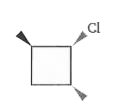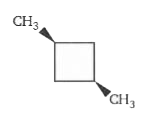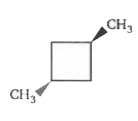Which of the following compounds does possess one or more asymmetric carbon atoms?
Propan-1-ol
Butan-2-ol
Acetic acid
Succinic acid
The correct Answer is:B
To determine which of the given compounds possesses one or more asymmetric (chiral) carbon atoms, we need to analyze each compound based on the definition of a chiral carbon atom. A chiral carbon atom is one that is bonded to four different groups.
1. Identify the Compounds: The compounds to analyze are propane-1-ol, butane-2-ol, acetic acid, and succinic acid.
2. Analyze Propane-1-ol:
- Structure: CH3-CH2-CH2-OH
- In propane-1-ol, the carbon atoms are as follows:
- The first carbon (CH3) is attached to 3 hydrogens.
- The second carbon (CH2) is attached to 2 hydrogens and 1 carbon.
- The third carbon (CH2) is attached to 2 hydrogens and 1 hydroxyl group (OH).
- None of the carbon atoms are attached to four different groups.
- Conclusion: Propane-1-ol does not have a chiral carbon.
3. Analyze Butane-2-ol:
- Structure: CH3-CH(OH)-CH2-CH3
- In butane-2-ol, focus on the second carbon (the one with the OH group):
- It is attached to:
- A methyl group (CH3)
- An ethyl group (CH2-CH3)
- A hydroxyl group (OH)
- A hydrogen atom (H)
- This carbon is attached to four different groups.
- Conclusion: Butane-2-ol has one chiral carbon atom.
4. Analyze Acetic Acid:
- Structure: CH3COOH
- In acetic acid, the carbon atoms are:
- The first carbon (CH3) is attached to 3 hydrogens.
- The second carbon (C=O and OH) does not have four different groups because it has a double bond to oxygen and is attached to the same hydroxyl group (OH).
- Conclusion: Acetic acid does not have a chiral carbon.
5. Analyze Succinic Acid:
- Structure: HOOC-CH2-CH2-COOH
- In succinic acid, the carbon atoms are:
- The first and last carbons (COOH) are each attached to two hydrogens and one carbon (not chiral).
- The middle carbons (CH2) are attached to two hydrogens.
- Conclusion: Succinic acid does not have a chiral carbon.
Final Conclusion:
The only compound that possesses one or more asymmetric carbon atoms is butane-2-ol.
---
- Structure: CH3-CH2-CH2-OH
- In propane-1-ol, the carbon atoms are as follows:
- The first carbon (CH3) is attached to 3 hydrogens.
- The second carbon (CH2) is attached to 2 hydrogens and 1 carbon.
- The third carbon (CH2) is attached to 2 hydrogens and 1 hydroxyl group (OH).
- None of the carbon atoms are attached to four different groups.
- Conclusion: Propane-1-ol does not have a chiral carbon.
- Structure: CH3-CH(OH)-CH2-CH3
- In butane-2-ol, focus on the second carbon (the one with the OH group):
- It is attached to:
- A methyl group (CH3)
- An ethyl group (CH2-CH3)
- A hydroxyl group (OH)
- A hydrogen atom (H)
- This carbon is attached to four different groups.
- Conclusion: Butane-2-ol has one chiral carbon atom.
- Structure: CH3COOH
- In acetic acid, the carbon atoms are:
- The first carbon (CH3) is attached to 3 hydrogens.
- The second carbon (C=O and OH) does not have four different groups because it has a double bond to oxygen and is attached to the same hydroxyl group (OH).
- Conclusion: Acetic acid does not have a chiral carbon.
- Structure: HOOC-CH2-CH2-COOH
- In succinic acid, the carbon atoms are:
- The first and last carbons (COOH) are each attached to two hydrogens and one carbon (not chiral).
- The middle carbons (CH2) are attached to two hydrogens.
- Conclusion: Succinic acid does not have a chiral carbon.
The only compound that possesses one or more asymmetric carbon atoms is butane-2-ol.
Topper's Solved these Questions
- ORGANIC CHEMISTRY : SOME BASIC PRINCIPLES AND TECHNIQUES Book:ICSEChapter:ORGANIC CHEMISTRY : SOME BASIC PRINCIPLES AND TECHNIQUES Exercise:TRUE OR FALSE TYPE QUESTIONS
Explore 50 Videos
- ORGANIC CHEMISTRY : SOME BASIC PRINCIPLES AND TECHNIQUES Book:ICSEChapter:ORGANIC CHEMISTRY : SOME BASIC PRINCIPLES AND TECHNIQUES Exercise:FILL IN THE BLANK TYPE QUESTIONS
Explore 46 Videos
- ORGANIC CHEMISTRY : SOME BASIC PRINCIPLES AND TECHNIQUES Book:ICSEChapter:ORGANIC CHEMISTRY : SOME BASIC PRINCIPLES AND TECHNIQUES Exercise:ESSAY ( LONG ANSWER ) TYPE QUESTIONS
Explore 42 Videos
- HYDROGENBook:ICSEChapter:HYDROGENExercise:NCERT TEXT-BOOK EXERCISE (With Hints and Solutions)
Explore 53 Videos
- REDOX REACTIONS (OXIDATION AND REDUCTION)Book:ICSEChapter:REDOX REACTIONS (OXIDATION AND REDUCTION)Exercise:NCERT TEXT-BOOK. EXERCISES ((With Hints and Solutions)
Explore 69 Videos
Similar Questions
Knowledge Check
Which of the following compounds possesses chiral carbon?
A B
B C
C D
D
Which of the following compound will not show tautomerism ?
A2,2-DimethylpropanalB2,2-Dimethyl-1 nitropropaneCAcetyl AcetoneDBenzophenoneIn which of the following compound, possess plane of symmetry as well as centre of symmetry?
A B
B C
C D
D
Which one of the following compounds does not show tautomerism ?
View SolutionIn which of the following compound has only one type of hybridised carbon atom?
View SolutionWhich one of the following compounds possesses the most acidic hydrogen?
View SolutionWhich of the following does not possess a carboxy group?
View SolutionWhich one of the following possesses winged petiole
View Solution

